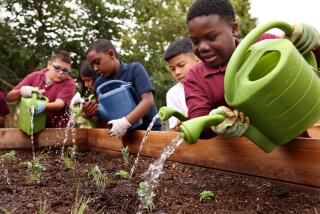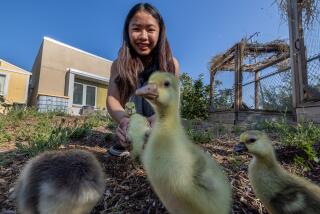Seeds of Learning : Children Weed Through Lessons From Mother Nature’s Classroom
- Share via
BURBANK — Just a few hundred yards from the noise and pollution of the Golden State Freeway, students at George Washington Elementary School are going back to nature.
Each week, the school’s nearly 700 students visit an innovative classroom, with no roof or walls. Instead of desks and blackboards, this quarter-acre, fenced “environmental park” has hundreds of plants, a dry stream bed and insects galore.
There the students learn “applied ecology”--a mix of gardening, forestry, water conservation and restoration of native habitats--although they don’t refer to it in such lofty terms yet.
“They’re fascinated with anything that wiggles,” said Kreigh Hampel, owner of an environmental education firm who helped establish the park-like garden and now works part-time as its supervisor and teacher.
Hampel, known to the kids as “Dr. Rot”--a moniker he was given for his presentations on composting--says his aim is to provide a “playful, yet practical” atmosphere that will inspire students to respect the Earth.
Three years in the making, the park began as a patch of asphalt-covered playground and has blossomed into a virtual mini-jungle through donations of funds, labor and plant stock from dozens of area businesses and conservation groups from across the country, Hampel said. Virtually all the moist, rich soil that supports plant life in the school’s little Eden was created via composting by the students.
School district officials boast that the park, which was fashioned after another built by an elementary school in Berkeley, is among only a handful in the country of similar size and scope.
“It’s a one-of-a-kind,” said Supt. David Aponik. “Not only in Burbank and the Valley, but it’s pretty unique in education circles.”
Bill Andrews, an environmental education consultant with the state department of education, praised the school’s self-starting spirit.
“We are highly supportive of what George Washington is doing. They’ve coordinated the input of the volunteers and the environmental groups and the local businesses to enable the project to sustain itself, and that’s a key element. They’ve also converted a piece of land that was just sitting there into something special.”
Andrews said the park is “larger than most” located on school sites in other districts, although Los Angeles Unified School District and some others have developed large environmental gardens on off-campus land.
Hampel said the project is about “developing relationships with nature. There are a lot of things that are going to need cleaning up on this planet in the future, and these kids are going to be the ones who have to do it,” Hampel said.
“If you can develop a romance with nature early on, things will start to shift. The next generations will just naturally be more sensitive to the environment.”
Megan Farnsworth, who teaches a third-grade bilingual class, said she has noticed a calming effect on her students when they roll up their sleeves and get their hands dirty by pulling weeds or planting.
“You can talk theory to kids about how plants grow, but once they plant something and actually watch it grow, something happens,” Farnsworth said. “Most of these kids live in apartments and have never experienced this. You can see definite changes in them, they’re learning to appreciate life a little bit more.”
*
Each class at George Washington maintains its own rectangular soil bed. There, the kids plant tomatoes, sunflowers, herbs, squash, artichokes and myriad other seeds. Surrounding the garden are tall trees producing almonds, apples, peaches, plums, figs, and even bananas.
In the future, Hampel hopes to add an amphitheater, a corn patch, a picnic area and a native plant collection.
“It’s fun, because Dr. Rot gives us seeds and we can take them home and plant them too,” said Freddy Mora, a third-grader. “Now I help my grandma plant in her garden.”
More to Read
Sign up for Essential California
The most important California stories and recommendations in your inbox every morning.
You may occasionally receive promotional content from the Los Angeles Times.










